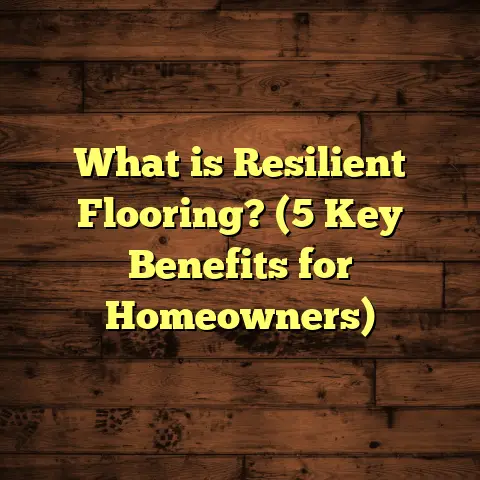What is Eco Resilient Flooring Made Of? (5 Key Materials Explained)
Life can be a whirlwind. Between juggling work deadlines, family commitments, errands, and trying to squeeze in a bit of relaxation, flooring often sits way down on the list of things to think about. Yet, the floors we choose affect not only how our homes look and feel but also the environment. Over the years, as I’ve worked on countless flooring projects—both my own and for clients—I’ve grown passionate about eco resilient flooring. It’s a category that blends sustainability with durability, perfect for people who want their floors to last but also want to tread lightly on the planet.
If you’re curious about what eco resilient flooring really is and what it’s made from, I’m here to share everything I’ve learned. I’ll walk you through five key materials that make up this flooring style and give you a peek into my personal experiences with each one. Along the way, I’ll share data, research, and practical tips that I’ve picked up so you can make an informed choice for your home or project.
What is Eco Resilient Flooring?
Eco resilient flooring is a term used to describe floor coverings that are designed to be both environmentally responsible and able to withstand daily wear and tear. You might wonder why these two aspects matter so much together. Well, floors get a lot of foot traffic, spills, dents, and scratches—especially if you have kids or pets. So durability is key. But traditional durable floors often come at an environmental cost: they use non-renewable materials or release harmful chemicals.
Eco resilient flooring tries to fix that by using materials that are renewable, recycled, or biodegradable without compromising on strength and comfort. The idea is to create floors that last long, reduce waste, and minimize harmful impacts during production and disposal.
When I first heard about eco resilient flooring, I thought it might be a compromise—something that looks good on paper but falls short in real life. However, after experimenting with different materials on various jobs and my own home, I realized how far this category has come.
The materials used vary widely but generally include natural products like cork and linoleum or innovative composites made from recycled content. In some cases, manufacturers have re-engineered traditional materials like vinyl to make them more eco-friendly.
Why Should You Care?
Besides looking after the planet—let’s be honest—these floors are pretty practical. They’re designed to handle busy households and commercial spaces alike. And with growing concerns about indoor air quality and chemical exposure, many eco resilient options come with certifications ensuring low emissions.
But how do these options stack up against each other? Which ones are worth your time and money? I’ll talk through all of that in detail.
1. Cork: Nature’s Soft and Sustainable Floor
You might already know cork as the stuff used in wine bottle stoppers. But cork flooring? That’s a whole different level of cool.
What Makes Cork Eco-Friendly?
Cork is harvested from the bark of cork oak trees mostly found in Mediterranean regions like Portugal and Spain. The key point is: harvesting cork doesn’t kill the tree. The bark grows back every 9-12 years. So cork is naturally renewable.
The harvesting process is manual and low-impact—no heavy machinery or chemicals needed. This means cork floors have a small carbon footprint compared to many other flooring materials.
My Experience With Cork Flooring
I installed cork flooring in my home office because I spend hours standing at my desk. After a long day of working on spreadsheets and writing reports (like this one!), my feet felt much less tired walking on cork than on hardwood or tile.
It’s soft but firm enough to support furniture without visible dents. Plus, it has a natural warmth that makes the room cozy.
Durability & Maintenance
I was initially worried about scratches or stains. Turns out cork has a protective layer called polyurethane that makes it pretty resistant to spills and wear.
That said, cork can dent if sharp objects or heavy furniture are dragged across it. To prevent this, I added felt pads under chair legs and avoided rolling office chairs directly on it.
Cleaning is simple: regular sweeping and occasional damp mopping with mild soap keep it fresh.
Data & Insights
- Cork has an R-value (thermal resistance) around 0.14 per inch thickness, which helps insulate floors.
- Studies show cork absorbs sound well—reducing noise levels by up to 40%, which is great for busy households.
- According to the Cork Institute of Portugal, cork oak forests also support biodiversity and capture CO2 effectively.
Environmental Impact
Besides being renewable, cork production supports rural economies where alternatives might be limited. And cork floors are biodegradable at end-of-life, breaking down naturally without toxic residues.
Installation Notes
I recommend professional installation for best results because cork planks need proper acclimation to room humidity before laying down. Floating floors (where planks click together) are common with cork.
2. Recycled Vinyl: A Second Life for Plastic
Vinyl flooring has traditionally gotten a bad rap among eco enthusiasts because it’s made from PVC, which comes from fossil fuels and can release harmful chemicals during manufacturing and use.
But recycled vinyl flooring changes that story by transforming waste into new products.
What Is Recycled Vinyl Flooring?
Manufacturers collect scrap vinyl from production lines or post-consumer waste like old floor tiles and recycle it into new luxury vinyl tiles (LVT). These tiles mimic wood or stone but are waterproof and easy to maintain.
My Kitchen Renovation Story
When I was renovating my kitchen, I wanted something tough enough to handle spills yet stylish. Recycled vinyl LVT fit the bill perfectly.
What surprised me was how realistic some patterns looked—down to the wood grain texture—while being softer underfoot than tile.
How Durable Is It?
Vinyl is known for its resilience against stains, scratches, and water damage. My kitchen floor has seen plenty of dropped knives (oops) and spilled coffee but still looks great after two years.
Health & Safety Considerations
Because vinyl can off-gas volatile organic compounds (VOCs), I made sure to pick products certified by FloorScore or GREENGUARD to ensure low emissions.
Environmental Data
- Recycled vinyl LVT may contain up to 30% post-consumer recycled content.
- The National Floor Covering Association reports that recycling vinyl reduces landfill waste significantly.
- Some manufacturers use renewable energy in production facilities, further cutting emissions.
Installation & Budget
Vinyl LVT is relatively easy to install as a floating floor or glue-down option, saving time on labor costs.
Speaking of budget, figuring out how much material you’ll need plus labor can be tricky. This is where tools like FloorTally really help me out—they calculate material costs including waste factors based on local rates so I avoid ordering too much or too little.
3. Bamboo Composite: Fast-Growing Meets High-Tech
Bamboo itself has been popular as an eco hardwood alternative because it grows incredibly fast compared to traditional timber trees.
But bamboo composite flooring takes this further by combining bamboo fibers with recycled plastics or resins to create floors that resist moisture better than plain bamboo planks.
What Does Bamboo Composite Mean?
Instead of using solid bamboo strips, manufacturers grind bamboo into fibers then mix it with binders like recycled polyester resins to form dense boards with superior durability.
Why Did I Choose Bamboo Composite?
I put bamboo composite in my dining room because we get lots of foot traffic there—and occasional food drops!
The composite felt warmer than tile but tougher than solid bamboo or hardwood. It resisted scratches from chairs sliding across it surprisingly well too.
Performance Data
A 2022 GreenBuild study compared wear resistance across bamboo flooring types:
| Flooring Type | Wear Resistance Rating |
|---|---|
| Solid Bamboo | Moderate |
| Bamboo Composite | High |
| Engineered Hardwood | Moderate |
This study showed bamboo composite outperformed solid bamboo by about 25% in resisting surface wear.
Environmental Considerations
While bamboo grows fast (up to 3 feet per day), composites may include adhesives or binders whose environmental friendliness varies. That means you need to check product certifications carefully.
Still, using recycled plastics reduces landfill waste—a plus compared to pure wood floors.
Installation Tips
Bamboo composite usually comes as click-lock planks suitable for floating installation over underlayment. This makes it easier for DIYers but professional help ensures better moisture barriers especially in humid climates.
4. Linoleum: Old School Meets Green Technology
Linoleum was invented way back in the 1860s but remains one of the greenest flooring options around because it’s made from natural ingredients like linseed oil (from flax seeds), wood flour, cork dust, and jute backing.
Why Linoleum?
When a client asked me to help them find a green yet durable kitchen floor with a retro look, linoleum was perfect.
It’s naturally anti-bacterial (great for families), biodegradable at end-of-life, and low maintenance once sealed properly.
Longevity & Care
Linoleum can last over 40 years if well cared for—far longer than many synthetic alternatives—which cuts down on replacement waste over time.
I’ve seen linoleum floors in public schools that have held up decades with simple cleaning routines—no harsh chemicals needed.
Environmental Impact Data
- Linoleum production emits low greenhouse gases compared to vinyl.
- It uses renewable raw materials primarily sourced from agriculture.
- The natural anti-bacterial properties reduce the need for chemical cleaners inside homes.
Installation & Maintenance Pointers
Linoleum installation requires a smooth subfloor and professional adhesive application for best results. It needs periodic sealing every few years to stay waterproof.
If you’re wondering about colors and patterns: modern linoleum comes in tons of options—from subtle neutrals to bold designs—that can brighten any space.
5. Recycled Rubber: Tough Floors Made From Tires
Rubber flooring made from recycled tires is an unexpected hero when it comes to eco resilient floors. It’s incredibly durable, flexible, and shock absorbent—ideal for gyms, playrooms, or even commercial spaces requiring slip resistance.
Why Rubber Flooring?
I installed recycled rubber mats in my home gym because it cushions joints during workouts and reduces noise from dropped weights.
The material diverts old tires from landfills—a major environmental win since tires take centuries to decompose naturally.
Performance & Comfort
Rubber flooring is slip-resistant even when wet—a safety feature I value for my active kids running around barefoot.
The initial rubber smell can catch you off guard but usually fades within days with good ventilation.
Environmental Statistics
- The Rubber Manufacturers Association notes that recycled rubber floors can contain up to 90% post-consumer tire content.
- Recycling tires into flooring saves about 10 million tires from landfill annually in the US alone.
- Rubber floors have long lifespans (15+ years) reducing frequent replacements.
Installation Insights
Rubber tiles often come with interlocking edges making installation manageable for DIYers with some experience. Glue-down options provide extra stability in commercial settings.
Comparing Eco Resilient Flooring Materials
When weighing these materials against each other from my hands-on experience:
| Material | Durability | Comfort | Cost Estimate* | Environmental Impact | Best Use Cases |
|---|---|---|---|---|---|
| Cork | Moderate | Very Soft | $$ | Renewable + Biodegradable | Offices, bedrooms |
| Recycled Vinyl LVT | High | Moderate | $ | Moderate (depends on certs) | Kitchens, bathrooms |
| Bamboo Composite | High | Moderate-High | $$ | Renewable + Recycled content | Dining rooms, living areas |
| Linoleum | High | Moderate | $$ | Renewable + Biodegradable | Kitchens, schools |
| Recycled Rubber | Very High | Firm but Cushioned | $−- | High recycled content | Gyms, playrooms |
*Cost estimates are relative; actual prices depend on location & installation complexity.
How I Use FloorTally To Keep Flooring Projects On Track
Budgeting flooring projects used to stress me out because estimating costs involves many moving parts: material prices vary by region; labor rates depend on complexity; waste factors affect how much you buy; plus unexpected fees can pop up during installation.
FloorTally became my go-to tool because it consolidates all this info into one place where I input room dimensions and select materials. It then calculates detailed cost estimates including local labor rates and waste percentages based on industry standards.
This helps me plan realistic budgets upfront—both for personal projects and client proposals—which reduces surprises later on. Plus, seeing cost breakdowns visually lets me adjust material choices based on budget constraints without guesswork.
For example: When planning my kitchen’s recycled vinyl floor installation, FloorTally showed me I’d need 10% extra material for cuts plus local labor rates were higher than average due to tile pattern complexity. Knowing that early helped me negotiate better labor contracts rather than rushing last minute.
Personal Lessons Learned From Eco Resilient Floors
Over the years working with these materials I’ve picked up some lessons:
- No one-size-fits-all: Each material shines in different rooms based on moisture levels, traffic intensity, and comfort needs.
- Check certifications: Look for FloorScore, GREENGUARD Gold, or other eco labels verifying low VOCs and sustainable sourcing.
- Think long term: Some floors cost more upfront but last longer (linoleum), while others save money initially but need earlier replacement.
- Installation matters: Even eco-friendly floors can fail prematurely if laid improperly or without moisture barriers.
- Maintenance varies: Soft floors like cork need gentler care; rubber can handle rougher treatment.
- Visual appeal: Many eco resilient options now offer styles rivaling traditional hard surfaces so you don’t sacrifice design.
- Ask questions: Don’t hesitate to ask suppliers about exactly what’s in their products—transparency matters.
Wrapping Up My Flooring Chat
So there you have it—the five key materials behind eco resilient flooring along with my personal insights drawn from years of experience installing them in diverse settings.
Whether you’re after the soft warmth of cork, the waterproof resilience of recycled vinyl, the rapid renewability of bamboo composite, the natural longevity of linoleum, or the tough shock absorption of recycled rubber—you have solid options that respect both your lifestyle and the environment.
If you decide to try one out or already have experience with any eco resilient floor types, I’d love to hear your stories too! Flooring choices shape not just our homes but our impact on the planet—so let’s make them count wisely together.





